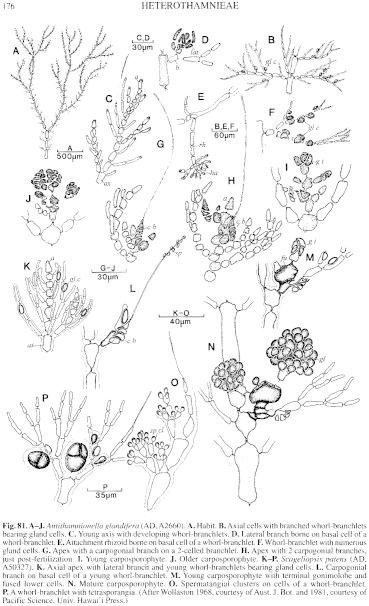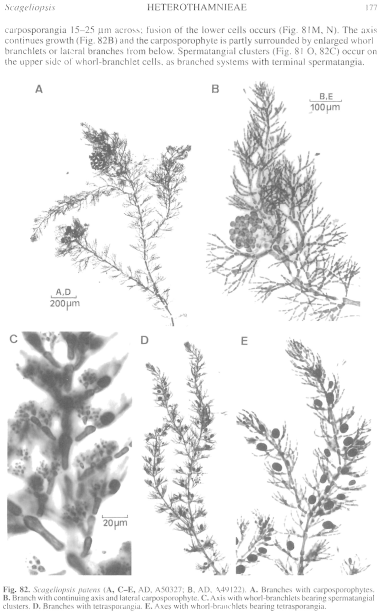|
|
|
|
|
|||||||||||
|
Electronic Flora of South Australia Species Fact Sheet
Phylum Rhodophyta – Order Ceramiales – Family Ceramiaceae – Tribe Heterothamnieae
Selected citations: Athanasiadis 1996: 178, fig. 87.
Thallus (Fig. 82A, D) erect, 2–10 mm high, axes sparsely laterally and radially branched, each axial cell with 3 similar-sized whorl-branchlets. Lower prostrate axial cells attached by rhizoids; usually epiphytic or epizoic. Structure. Apical cells 5–8 µm in diameter and L/D 1.2–2, with a chain of 4–12 small cells (Fig. 81K), then enlarging to 12–15 µm in diameter and to 30–45 (–55) µm in diameter and L/D (1.5–) 2–5 (–8) in mid and lower axial cells, with thick walls. Each axial cell with a whorl (Fig. 82B, D, E) of 3 (rarely 2 or 4) similar whorl-branchlets, 90–140 and 4–7 cells long, perpendicular to slightly upwardly curved to the axes, branched 1–3 times from the basal cell and soon appearing subdichotomous more or less in a horizontal plane to the axes; basal cells of whorl-branchlets usually slightly larger than next outer cell, 8–12 µm in diameter and L/D 2–3, tapering evenly to terminal cells 5–7 µm in diameter and L/D 2–3, with rounded ends and often bearing a long hair; gland cells (Fig. 81K, P) cut off from terminal or lower cells of whorl-branchlets, usually touching only the bearing cell, ovoid, 8–12 µm in diameter. Lateral branches arise from the basal cells of whorl-branchlets (Fig. 81K). Cells uninucleate; rhodoplasts discoid to elongate in small cells, ribbon like in larger cells.
Reproduction: Gametophytes dioecious. Carpogonial branches (Fig. 8IL) borne, usually only one per branch, on the basal (=supporting) cell of >whorl-branchlets; post fertilization a connecting cell transfers the diploid nucleus to the auxiliary cell, which cuts off an upper gonimoblast initial (Fig. 81M) and later successive gonimolobes 100–250 µm across of ovoid carposporangia 15–25 µm across; fusion of the lower cells occurs (Fig. 81M, N). The axis continues growth (Fig. 82B) and the carposporophyte is partly surrounded by enlarged whorl-branchlets or lateral branches from below. Spermatangial clusters (Fig. 81O, 82C) occur on the upper side of whorl-branchlet cells, as branched systems with terminal spermatangia.
Tetrasporangia (Figs 81P, 82D, E) are borne on inner and central cells of whorl-branchlets, situated adaxially, sessile, ovoid, 20–35 µm in diameter, decussately or cruciately divided.
Type from Port Stanvac, S. Aust., on bryozoans on jetty pylons, 3–12 m deep (Clarke & Engler, 14.iv.1979); holotype in AD, A50327.
Selected specimens: Semaphore, S. Aust. (coll. unknown, 7.i.1977; AD, A50320). Port Stanvac, S. Aust., on jetty pylons, 3 m deep (R. Lewis, 24.ii.1972; AD, A41320), and 3–12 m deep (Clarke, 23.ii.1977; AD, A47974). Port Noarlunga, S. Aust., 2–5 m deep (Hergstrom & Owen, 19.vii.1970; AD, A35972) and 6 m deep (Ricci, 18.iv.1993; AD, A61937).
Distribution: Only known from Semaphore to Port Noarlunga, S. Aust., but probably more widely distributed.
References:
ATHANASIADIS, A. (1996). Morphology and classification of the Ceramioideae (Rhodophyta) based on phylogenetic principles. Opera Botanica No. 128, pp. 1–216.
WOLLASTON, E.M. (1981). Descriptions of two new genera, Scageliopsis and Glandothamnus (Ceramiaceae, Rhodophyta), including five previously undescribed species from southern Australia. Pacific Sci. 34, 109–127.
The Marine Benthic Flora of Southern Australia Part IIIC complete list of references.
Publication:
Womersley, H.B.S. (24 December, 1998)
The Marine Benthic Flora of Southern Australia
Rhodophyta. Part IIIC. Ceramiales – Ceramiaceae, Dasyaceae
©State Herbarium of South Australia, Government of South Australia
Illustrations in Womersley Part IIIA, 1998: FIGS 81 K–P, 82.

Figure 81 enlarge
Fig. 81. A–J. Antithamnionella glandifrra (AD, A2660). A. Habit. B. Axial cells with branched whorl-branchlets bearing gland cells. C. Young axis with developing whorl-branchlets. D. Lateral branch borne on basal cell of a whorl-branchlet. E. Attachment rhizoid borne on basal cell of a whorl-branchlet. F. Whorl-branchlet with numerous gland cells. G. Apex with a carpogonial branch on a 2-celled branchlet. H. Apex with 2 carpogonial branches, just post-fertilization. L Young carposporophyte. J. Older carposporophyte. K–P. Scageliopsis patens (AD, A50327). K. Axial apex with lateral branch and young whorl-branchlets bearing gland cells. L. Carpogonial branch on basal cell of a young whorl-branchlet. M. Young carposporophyte with terminal gonimolobe and fused lower cells. N. Mature carposporophyte. O. Spermatangial clusters on cells of a whorl-branchlet. P. A whorl-branchlet with tetrasporangia. (After Wollaston 1968, courtesy of Aust. J. Bot. and 1981, courtesy of Pacific Science, Univ. Hawai'i Press.)

Figure 82 enlarge
Fig. 82. Scageliopsis patens (A, C–E, AD, A50327; B, AD, A49122). A. Branches with carposporophytes. B. Branch with continuing axis and lateral carposporophyte. C. Axis with whorl-branchlets bearing spermatangial clusters. D. Branches with tetrasporangia. E. Axes with whorl-branchlets bearing tetrasporangia.

|
Email Contact: State Herbarium of South Australia |

|